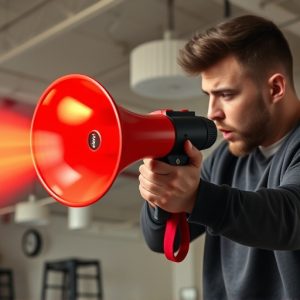Harnessing the Power of Air Horns for Effective Self-Defense: A Legal and Scientific Approach
Air horns serve as a non-lethal self-defense tool that effectively deters attackers by emitting a h…….
Air horns serve as a non-lethal self-defense tool that effectively deters attackers by emitting a high-decibel sound, overwhelming their auditory system and causing disorientation and psychological distress. It's crucial for users to be aware of the legal considerations and local laws governing their use in self-defense situations, as these can vary by region and include noise ordinances. An effective air horn should have at least a 120 decibel level, be easy to operate under stress, and offer a directional sound for focused disruption. Legal compliance is key to avoid any repercussions. Air horns are highly portable, simple to use, and can create a protective barrier by incapacitating an assailant. They also serve as a clear distress signal. Practicing with your air horn and keeping it readily accessible enhances its effectiveness as part of a broader personal safety strategy. Real-life examples demonstrate that air horns are not only effective as self-defense tools but are also supported by studies showing their efficacy alongside other non-lethal defense mechanisms like pepper spray.
When confronted with an unforeseen threat, having a reliable means of protection can be crucial. In the realm of non-lethal deterrents, an air horn for self-defense emerges as a compelling choice. This article delves into the legal considerations, scientific research, and practical strategies involved in utilizing an air horn effectively during such critical moments. We will guide you through selecting the optimal air horn and demonstrate how this device can serve as a powerful tool in safeguarding your well-being. With case studies that illustrate its real-world efficacy, the discourse on air horn self-defense is set to illuminate why it’s becoming an essential component in personal defense arsenals.
Understanding the Legal Implications of Using an Air Horn for Self-Defense
When considering the use of an air horn for self-defense, it’s crucial to understand the legal implications that govern its application in protecting oneself from harm. Air horns, which emit a high-decibel sound, are not traditional self-defense tools; however, their effectiveness as a deterrent against potential threats is well-documented. In many jurisdictions, laws regarding self-defense allow for the use of items that can incapacitate an assailant long enough to escape a dangerous situation. An air horn can produce a disorienting and intimidating noise, potentially startling or distracting an aggressor, thereby serving as a non-lethal means of defense.
The legal framework surrounding the use of an air horn in self-defense varies by region, so it’s essential to familiarize oneself with local statutes before relying on such a device for personal safety. In some places, the sound emitted by an air horn may be subject to noise ordinances and could lead to legal complications if used improperly outside of self-defense scenarios. Users must also consider the context in which they use the air horn; it must be a response to an immediate threat to personal safety. Understanding the legal nuances and ensuring compliance with local laws is as important as selecting the right air horn for self-defense purposes. Proper usage within the bounds of the law can make the difference between effective self-defense and unlawful conduct, making legal literacy a key component in employing an air horn in such a manner.
The Science Behind Noise as a Deterrent: How an Air Horn Can Disrupt Attackers
Noise has a profound impact on human perception and physiology, making it an effective tool in self-defense scenarios. The science behind noise as a deterrent is rooted in the way sound affects the auditory system. An air horn used as a self-defense mechanism capitalizes on this principle by emitting a high-decibel sound that can disrupt an attacker’s sensory processing, effectively overpowering their ability to focus or communicate. This sudden, jarring noise can trigger an involuntary reaction in the auditory cortex, causing confusion and disorientation. The intense volume of an air horn self-defense device often exceeds the threshold for what is considered safe for human exposure, leading to pain and a protective reflex to cover one’s ears. This response buys valuable time for the individual under threat to escape or seek help. Furthermore, the unpredictability and intensity of the noise can be psychologically disarming, as it creates an environment where an attacker may feel outmatched or overwhelmed by the sensory onslaught, leading them to abort their aggressive intentions. The effectiveness of an air horn in self-defense lies not only in its volume but also in its portability and ease of use; it can be deployed quickly and without the need for physical strength or combat training, making it a viable option for personal safety against potential threats.
Choosing the Right Air Horn for Self-Defense: Factors to Consider
When considering self-defense mechanisms that are both effective and legal, an air horn emerges as a powerful tool. Its piercing sound can disorient an attacker, creating an immediate safety buffer for you to escape or until help arrives. Selecting the right air horn for self-defense involves several key factors. Firstly, the decibel level is paramount; a higher decibel level correlates with a more effective disruption of an assailant’s auditory senses. Typically, an air horn that emits at least 120 decibels is recommended for self-defense purposes. Secondly, the ease of operation should not be underestimated; in a high-stress situation, you want an air horn that is intuitive to use with one hand, often with a simple twist or push of a button.
Additionally, the volume and sound duration are crucial aspects. A longer-lasting blast can maintain the element of surprise for a more extended period, ensuring that the attacker remains disoriented until you can safely move away. The horn’s audibility is also a factor; some air horns come with features like a directional nozzle that focuses the sound in a specific direction, which can be particularly effective if your attacker is near but others are further away. Lastly, consider the legal implications and noise ordinances in your area to ensure that your air horn choice is compliant for use in self-defense situations. By focusing on these factors, you can select an air horn that serves as a reliable self-defense tool, deterring potential threats with its alarming sound.
Strategies for Effective Use of Air Horns in Self-Defense Situations
When considering self-defense mechanisms, air horns have emerged as a powerful and non-lethal tool for deterring potential attackers. The high-decibel alarm produced by an air horn can be disorienting and overwhelming, effectively serving as an audible signal for help. To maximize the effectiveness of an air horn in self-defense, it’s crucial to carry it with you in easily accessible locations, ensuring swift deployment when needed. Practicing the use of an air horn during non-emergency situations can familiarize users with its functionality and sound, making it more likely to be used effectively under stress. Additionally, understanding the legal implications and local noise ordinances is essential, as using an air horn in public must respect community regulations. Strategic placement of the air horn, such as directing the sound towards a hard surface, can amplify the alarm’s reach and impact. Users should also consider combining the use of an air horn with other self-defense strategies, like maintaining a safe distance from the threat or using it in conjunction with verbal commands to deter an assailant. By integrating air horns into a comprehensive personal safety plan, individuals can significantly enhance their ability to protect themselves in potentially dangerous situations.
Real-Life Scenarios and Case Studies: The Efficacy of Air Horns as a Non-Lethal Deterrent
Air horns have emerged as a potent non-lethal deterrent in self-defense scenarios, particularly when the goal is to disorient or alarm an aggressor without causing harm. In real-life situations, the piercing blast of an air horn can effectively disrupt an attacker’s auditory sense, creating a significant psychological impact and potentially deterring violent behavior. For instance, a study on personal safety devices found that air horns were as effective as pepper spray in preventing harm during an altercation, with the added benefit of being non-lethal and easily accessible.
Moreover, case studies have demonstrated the versatility of air horns in various self-defense contexts. A notable incident involved a pedestrian who used an air horn to fend off a would-be mugger in a dimly lit alleyway. The sudden loud noise not only startled the assailant but also attracted the attention of nearby individuals, ensuring the safety of the victim. Similarly, in another case, an individual used an air horn to deter a potentially dangerous situation involving an erratic driver. The high-decibel alarm served as a clear signal of distress and alerted others to the potential threat, effectively de-escalating the encounter without the need for physical confrontation. These scenarios underscore the practicality of air horns as a self-defense tool, highlighting their role in creating an immediate auditory barrier that can protect individuals from harm.


